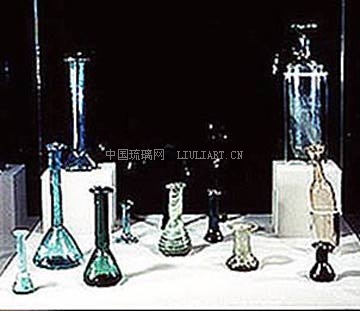With the development of free-blowing, the rather staid uniformity and refinement of cast vessels often gave way to directives of speed, spontaneity, and formal ingenuity. Less architectural in profile, blown vessels of antiquity often achieved a graceful, thin-walled elegance or a loose, plastically volumetric vigor. Depending upon the quality of the raw glass, the finished product might yield a bubbled, grainy texture or a compact and pure one.
The iridescence seen on much ancient glass was not a deliberate effect created by the glass-maker. It was caused by devitrification (chemical decomposition) due primarily to prolonged contact of the objects with moist and acidic soil in their archaeological contexts. Paradoxically, vessels displaying this opaline quality are coveted by many collectors of antiquities because of their aesthetic appeal; and the effect is frequently imitated by modern glass-artists.
Since the majority of glass and artifacts in the collections of the Kelsey Museum come from Egypt, with its dry climate, relatively few of them illustrate this phenomenon. They appear for the most part as they were intended to look some 1500 years ago.
The invention of glass-blowing occurred within an historically critical span of time. In the middle years of the first century B.C., the power of Rome was fanning out to embrace East and West in a military/political hegemony that would provide the substructure for expansive trade networks and patterns of cultural exchange. The blossoming of this internationalism is mirrored in the glass industry of the Roman Empire. Rome asserted its control over the two dominant glass-making centers of the late first millennium (Syro-Palestine and Egypt) in 62 and 30 B.C., respectively.

Simultaneously, the raw territories of the West (where glass had no history) were being brought within the orb.
It is telling that the earliest known ancient representation of glass-blowing has been found not on an object from Phoenicia, but on an object from Split, Yugoslavia: a decorated clay lamp datable to the first century B.C.; and, while Syro-Palestine and Egypt maintained their traditional importance as glass-making centers, glasshouses were already in operation in Cologne, Germany (to offer one example) by the middle of the first century B.C. Cologne rapidly developed a major industry which was continuously responsive to trends set further east, while also responsive to local predilections.
Until well into the fifth centry A.D., when effects of the political dissolution of Empire began to be reflected perceptibly on the level of material culture, there was a remarkable unity in glass-making across the entire extent of Rome's purview. Not only did glass products travel (both as objects of intrinsic trade value and as receptacles for liquid commodities, but so also did glass-makers. This is clear from a variety of textual, epigraphical, and artifactual evidence.
Within a few hundred years from the invention of free-blowing, glass-blowers had developed almost all the major decorative techniques which are used by glass artists even to the present day. Thus, in essence, the glass of the Roman Empire provides a telescoped view of the techniques of art in glass generally, from antiquity until the emergence of the studio movement in our own era. The one major exception was the concept of stained glass windows, not envisioned until the Middle Ages.
上一页 [1] [2] [3] [4] [5] [6] [7] [8] 下一页
|




